Bornova, located at the foot of Mount Yamanlar, on 380 northern latitude and 270 degrees longitude, is 8 km away to İzmir. Within the scope of Address Based Population Registration System for 2012, the population of Bornova is 423.063.
The height above sea level varies between 20 and 200 meters in residential areas. This height reaches up to 600 m in mountainous regions and even exceeds it. The flat plain located in the south of the district center is the Bornova Plain. It consists of the merger of the plains of Bozalan, Hacılarkırı, Karasuluk, Mersinli, and Bayraklı. These plains are generally formed by the accumulation of alluviums brought by the waters descending from the slopes. The area of the district is 220 km2. Mediterranean climate prevails in the district. Summers are hot and dry, winters are warm and rainy. In summer, imbat and poyraz winds are effective. In the winter, northwest winds, southwest and northeaster winds bring dry cold. There are calabrian forests at heights up to 600 meters, and larch forests at higher heights. The forest areas in the district are rich in water. There is water flowing from the slopes and there are rivers fed by precipitation. Manda Stream, Kavaklıdere Stream, Şeytanderesi Stream, Bornova Stream, Nif Stream are important rivers. There is İkizgöl located on Yamanlar Mountain. It consists of one of the important resting areas of the district among pine forests.
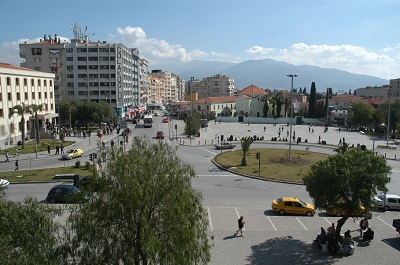

WHERE DOES THE NAME ‘BORNOVA’ COME FROM?
The settlement started in Hellenistic age in Bornova whose oldest known name is Birun-u Abad. Although the name was mentioned in the Ottoman records as Birunabad, that the word ‘birun’ which means ‘’external, outer’’ in Farsi does not generally correspond to the ‘’--abad’’ affix (such as Islamabad, Hyderabad) which is often used together with a special name in place names suggest that ‘’Birunabad’’ is the version of a name which may have been tampered with or modified. It was also suggested that the name was originally referred to as "Burunova". The Amazons, the Hittites, the Ionians, the Phrygians, the Lydians, the Persians, the Macedonians, the Pergamon Kingdom and the Romans ruled and lived in this region.
During the liberation of İzmir from occupation on 9 September 1922, many Levantine mansions and houses in Bornova were used as headquarters by the Turkish army. After the War of Independence, the Greek population left Bornova and some of the Levantine kept residing in here. Bornova met the loss of population arising from the Greek migration through the migration from Balkans, Crete and Anatolia.
The District Center, which was established at the foot of Yamanlar Mountain, has grown rapidly as a result of rapid industrialization, intensive migration from villages and especially from the east, the establishment of Ege University and the increase in the number of soldiers. Although the population has grown as a result of the merger with the settlement centers which used to be a village, the slums in the district are almost negligible. Bornova, known for its green, okra, tomato, pomegranate gardens and picnic areas, has hosted different cultures in the course of history and still continues this mission. Some of the historical mansions, houses and works that have not lost their characteristics from recent past to the present day are as follows: Maltas House, Belhomme House, Paterson Mension, Steinbüchel House, Chamaud House, Charlton Wittal House, Well House, Edmund Giraud House, Donald Giraud House, Kanalaki House, Aliotti House, Murat House, Bari House, Pandespanian Mansion, Paggy Mansion, Green Mansion , Bornova Grand Mosque, St. Maria Magdalena Protestant and Santa Maria Catholic Churches.
Numerous parks, children's gardens, tea gardens and neighborhood grounds are available to meet the public's need for relaxation and entertainment.
BORNOVA HISTORICAL ANCIENT PERIOD
The settlement started in Hellenistic age in Bornova whose oldest known name is Birun-u Abad. The Amazons, the Hittites, the Ionians, the Phrygians, the Lydians, the Persians, the Macedonians, the Pergamon Kingdom and the Romans ruled and lived in this region.
Bornova, which was the first civilization in 600 BC, has been the living space of many civilizations from past to today. Bornova has been one of the focal points of Western researchers and travelers who has since the 17th century. It is understood that this region was a fertile agricultural area in the Ottoman period and a summer resort due to its dense vegetation. It is known that the plain is very rich in water resources.
Bornova Plain, which has favorable environmental conditions with rich vegetation and animal resources in the prehistoric period, hosted the first settlers of İzmir. The ruins of the oldest settlement were found in Yeşilova Mound (www.yesilova.ege.edu.tr). As a result of the excavations carried out in 2005 and 2006, it was understood that the Yeşilova Mound, which was unearthed in the Bornova Plain, is the oldest known settlement not only in Izmir but also in the Aegean Region. It was found that the first communities started to settle on Yeşilova Mound 8500 years ago.
Yeşilova Mound and Yassıtepe Mound located at 400 m. north to the mound and along with the presence of five mounds such as Bayraklı, Pınarbaşı and Bornova Anatolian High School mounds in the plain, revealed the presence of dense old settlements in Bornova. With these prehistoric settlements, the history of both Bornova and Izmir dates back to a much older history than is known.
With the increasing population in later ages, the people of Izmir moved to the west of the Bornova Plain in accordance with needs, to Smyrna-Tepekule in 64-545 BC and to Kadifekale in 300 BC respectively, and continued their cultural and economic development.
TURKISH DOMINATION AND REPUBLIC PERIOD
The Turks, who stepped into Anatolia with the victory of Malazgirt in 1071, gave the management of Bornova to Emir Çakabey in 1076. Bornova, which was occupied by the Greeks on May 15, 1919 after the collapse of the Ottoman Empire, escaped from the enemy occupation on September 9, 1922 when the Turkish Army under the leadership of Mustafa Kemal ATATÜRK entered the back of Belkahve. Bornova was established in 1881 as the first municipality organization. Since 1981, it has been serving a function as the metropolitan municipality of Izmir Metropolitan Municipality. The first football match occurred in Türkiye in 1890 with the British sailors that came to Izmir and in Bornova among the youngsters from İzmir. Also, the first athletics competitions of our country took place in Bornova in 1895.
On 9 September 1922, during the liberation of İzmir from occupation, many levantine mansions and houses in Bornova were used as headquarters by the Turkish army. After the War of Independence, the Greek population left Bornova and some of the levantines kept residing in here. Bornova met the loss of population arising from the Greek migration through the migration from Balkans, Crete and Anatolia. The Agricultural School, built in 1932 on the Bornova plain, known for its fertile soil, is the core of Ege University which was founded in 1955. Bornova, which gained district status in 1958, has started becoming a student city since the 1960s thanks to the Ege University campus. The growth and development of the Faculty of Medicine Hospital in the Aegean and the country is one of the main factors that made Bornova an attraction center.
The fact that two major military units are located in the district along with the university factor and the two dominant axes in the vicinity (Kemalpaşa Plain and Işıkkent) are identified as industrial zones and the presence of 4 industrial sites within the residential area are the main factors that will affect the development of Bornova today and in the future. Pınarbaşı has become the lung of İzmir with Çiçekli and nearby villages; it has increased its importance one more time with İzmir-Ankara being located at the center of İzmir-Aydın and İzmir-Çanakkale highway network and also with the arrival of subway and Central Garage in 2000.
HISTORICAL PLACES IN BORNOVA
Peterson Mansion
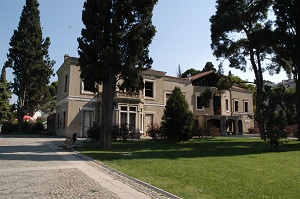
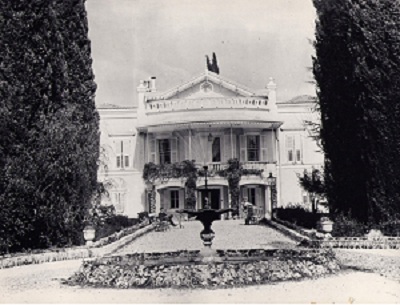
It was built in 1859 by the British merchant John Peterson. Many building materials of the 38-roomed mansion on today's Mustafa Kemal Street have been brought from Europe and the UK. The mansion, which has undergone seven changes, was initiated in 1991 by the Ministry of Culture. With the approval of the High Council of Monuments, the Metropolitan Municipality made environmental planning on an area of 54 thousand square meters. The Ministry of Culture leased the right to use the Peterson Mansion to the Izmir Metropolitan Municipality for a period of 49 years.
Santa Maria Catholic Church
The construction date of the church next to Kars Primary School in Bornova Cumhuriyet Square is 1797. The structure, built by Franciscan sect, is in Byzantine style and still continues its mission.
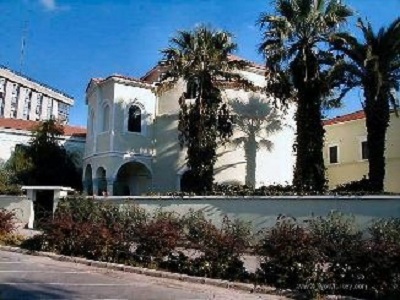
Paggy Mansion
Located opposite the Rectorate building of Ege University, the mansion was built in 1800 by Fontan d'Escalon. The restored mansion still maintains its vitality.
Pandespanian Mansion
The last stop of the old railway station and the mansion at the entrance to the university campus was built in 1880 by the Pandespanian family. The mansion, which was restored by Ege University, is used as the social facility of the university with its exquisite architectural style today.
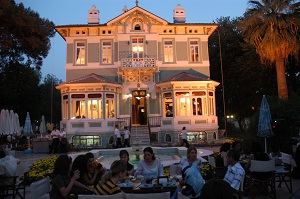
Murat House (Haunted House)
Murat House, known as the 'Haunted Mansion' among the people, is located at the intersection of Fevzi Çakmak Street and Gençlik Street. The building was built in 1880 by the British Edwards family. At the back of the large garden there is a hammam that faces destruction.
Rumor has it that for many years a virgin girl stopped by the mansion at night and carried something inside of it. The name of the mansion is called ‘’Haunted Mansion’’ among the people due to this narration becoming notorious from language to language.
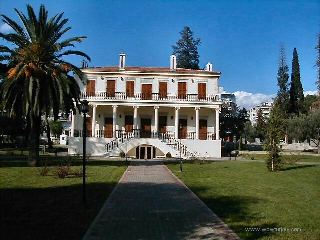
Belhomme House
It was built in 1880 by the British architect Clark, who built the house of Aliberti House. It was recently restored by Helene ARMAND, who is of the Belhomme family and a member of UNESCO. The building has a magnificent façade and magnificent columns at the entrance. Relay and restoration of the building was done in 1997 by the Mayor of the time, Prof. Dr. Aysel BAYRAKTAR.
The building located on Fevzi Çakmak Street next to İş Bank at no: 34, is currently used as the Library of Bornova Municipality (Atatürk Library).
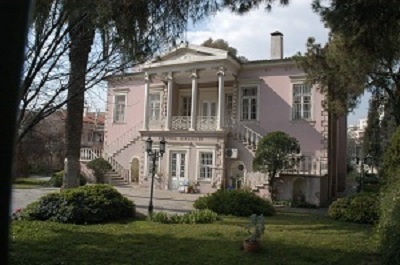
Steinbuchel House
The mansion, which is located on Hürriyet Street, still opposite the Ege University Rectorate building, was built in 1860 by British John Maltass. In the War of Independence, this magnificent mansion was used as the headquarter of Atatürk.
Tristramp Mansion
Built in 1904, it is the residence of the British Tristramp family (A.Giraud). According to land registry records, The Tristramp Mansion, which was transferred to Turkish Republic State Treasury in 1948, is now allocated to the Ministry of Culture and Tourism. The building located on the main wall of Gençlik Street, along with having an entrance to the garden, is in physical contact with the road with a facade. The main living spaces on the ground floor are differentiating with their differing floor coverings, dense plaster decorated moldings, ceiling rose and corner coat of arms, plaster and fireplaces.
It is noteworthy that on the road facade facing the social use of the building it refers to the local architecture while on the inward-facing garden facades it refers to the Western expression. This dual attitude suggests that the user family has an attitude that fuses with the local identity as well as the Western identity and does not emphasize its privileged position.
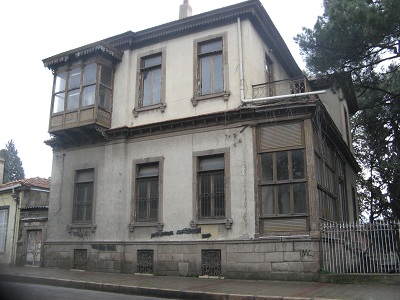
Charlton Whittal (Big House)
The mansion, which is located on the Gençlik Street and is currently used as the Rectorate Building of Ege University, was used as a monastery of Dutch nuns in history. The owner of the house is Charlton Whittal, founder of the famous Whittal Company. The house which was sold to the Giraud family later passed to the Turkish authorities.
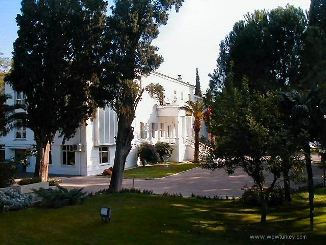
Giraud Houses
The mansion, which is located on Fevzi Çakmak Street, opposite the Dokuz Eylül Primary School near today's Art Street, was built in 1860 by William Giraud. William Giraud's father is one of the founders of the first textile factory in Türkiye. For many years the building was used as the Consulate of Venice by Lui Cortazzi, the nephew of Jean BAPTISTE.
St. Mary Magdalene Anglican Church and Cemetery
It is the Anglican Church located at Erzincan Mahallesi on Gençlik street No. 20 in Bornova district. It is one of the three sub-churches of the Great Anglican Church which was founded on the same date as the establishment of the Levant Company at the end of the first quarter of the 18th century. It was built in 1857 for the Anglican community living in Bornova by Charlton Whittall, the first Whittall settled in Türkiye. This church has been the only place of worship for the great Anglican community in Bornova.

BELKAHVE AND ATATÜRK MONUMENT
It is the place between the Bornova Plain and Kemalpaşa Plain, which is formed by the alluvial descent from the surrounding slopes, which is also known as Kahveci Beli located 10 km on the east of İzmir and on Ankara-İzmir highway, and reaches 250 meters in height. On the arrival from Turgutlu, the first point where the Gulf of İzmir appeared and the passage at this point takes the name of “Belkahve’’ from the café where Mustafa Kemal Pasha and his retinue watched İzmir on the Independence Day of İzmir.
At the point where the Great Leader Atatürk saw and watched Izmir for the first time in Belkahve after the liberation, there is also the uniformed statue of Mustafa Kemal Pasha, which was built by the sculptor Tankut Öktem in 1991, on a base climbed by the stairs and which is 16 meters high.

RECREATION AREAS
THE HOMER VALLEY
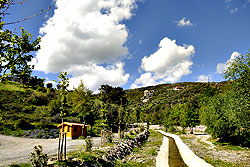
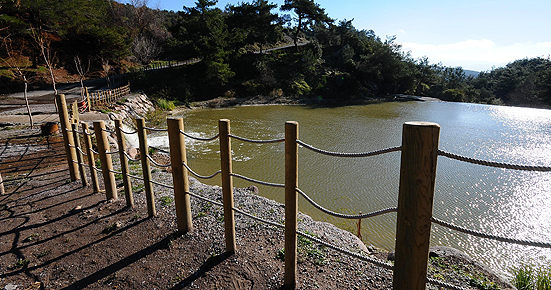
A complete recreation area has been created for the people of İzmir who want to get away from the busy life of the city for the need of daycation. The bed of the Bornova Stream, which stretches between the center of Bornova and Kayadibi, became a brand new face with the Homer Valley Project. Both to prevent flooding, as well as to create new recreation areas in the city Bornova Watercourse was implemented by conceptualizing the Homer Valley project.
The ponds and water embankments were built along the valley which is about 7 kilometers long; picnic areas surrounded by flowers and trees were organized. Wooden seating groups in harmony with nature were placed in picnic areas and security teams were established to secure the area. According to the belief of the people, there is a cave and rock mass in the lower part of Bornova Stream and it is assumed that the famous bard Homer, who is known to be from İzmir, lived here and this project was tried to be made an attraction center for the world humanity and named as Homer Valley. The Homer Valley consisting of 500.000 m² which contributes to the ecological structure of the city and in which endemic plant species unique to İzmir were used without disturbing the structure of the nature, has become a natural wealth for people who want to get away from the busy life of the city.
In suitable places in the valley 3.001 trees in total were planted along with horse chestnut, linden, plane tree, sweetgum and coniferous species such as cedar, spruce tree and umbrella pine. In addition to that, 31.777 bushes were planted such as pistachio species like oleander, cranberry, laurel, lilac, berberis. Moreover, for the coloration 156.920 ground cover, seasonal and hugging plants were planted, including basement daisies, mesem and mule nails. In addition to picnic tables and children's playgrounds as a result of the works made in the third part of the valley, ground cover plants were painted purple color.
In The Works Made For Homer Valley Endemic Species;
2 species in 2 families in ferns, 4 species in 3 families in gymnosperms; 146 species in 46 families in dicotyledons, 29 species in 5 families in monocots; 182 species of plants and 103 bird species were identified in 54 families in total.
( Source:http://www.izmir.bel.tr/projelerb.asp.)
BORNOVA AŞIK VEYSEL RECREATION AREA
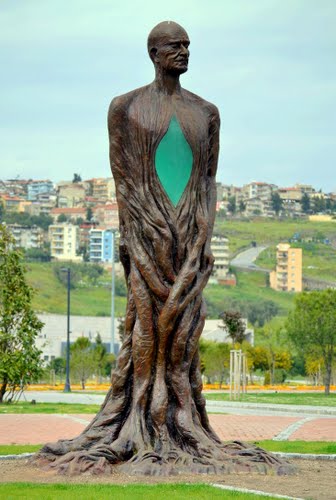
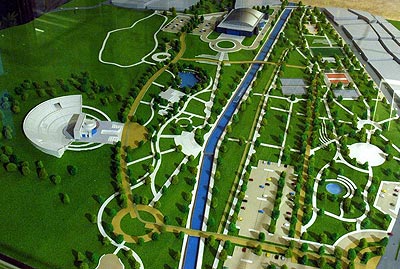
It consists of the Aşık Veysel Recreation Area in Bornova and the giant complex including the Olympic ice skating and amphitheater located in it. Bornova and İzmir are a new recreation areas with very important new sports and culture and art venues. On a total area of 231.000 m², 527 parking spaces, 125.000 m² green area, 352 m² and 142 m² cafeterias, 135 m² shower and WC building, three basketball courts with a total area of 2.079 m², two tennis courts with a total area of 1089 m² court, 1215 m² mini football field, 180-220-350 m² sand-children area, 280 m² 2 sports equipment areas in total of 280 m² , 1550 m² pond, 10,000 m² floor brick-pedestrian path, 34,500 m² granite cube stone pedestrian road, 1.6 km long bike path and an amphitheater with a capacity of 5,000 people with a total construction area of 7.693 m² have been built. The completed facilities were put into service on 25 September 2010.
( Source:http://www.izmir.bel.tr/projelerb.asp.)
Ice Skating Hall
Ice Skating Hall, which is located in the Aşık Veysel Recreation Area of Bornova consists of the basement, ground floor and first floors whose total construction area of 12,000 m There are olympic ice rink and ice hockey pitch (1830 m²), shelter, technical rooms, changing rooms, coach rooms, WCs, showers in the building, and on the ground floor there are tribunes, ticket sales, offices, club rooms, there are vip tribunes on the first floor, press stands, cafes, broadcasting rooms. It has a grandstand of 1751 people including spectators, VIPs, press and disabled people and an open parking lot for 66 vehicles. It came into use on 25 September 2010.
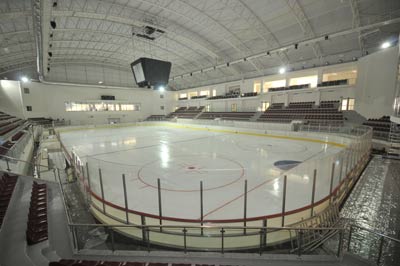
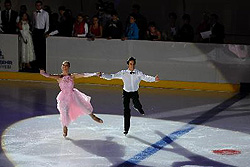
TOURISM STATISTCS:
The Number of Certificated Accommodation Facilities by Ministry of Culture and Tourism:
--Accommodation
Facilities-- | Operation Certificated Facilities | Investment Certificated Facilities | TOTAL |
Number of Facilities | Number of Rooms | Number of
Beds | Number of Facilities | Number of Rooms | Number of
Beds | Number of Facilities | Number of Rooms | Number of
Beds |
BORNOVA | 5 | 280 | 564 | 1 | 75 | 150 | 6 | 355 | 714 |
The List of Tourism Operation Certificated Facilities in the District
| Name | Address | Phone/ Fax | Website/ E-mail |
** | Ege Güneş Oteli | Fatih Cad. No:69 Çamdibi
| 461 55 65 435 53 46 |
|
**** | Anemon Ege
Sağlık Oteli
| Ege U. Tıp. Fak. Ark. Bornova
| 373 48 62
373 48 63 | ege@anemonhotels.com |
| Ö | Villa Levante | Erzene Mah. Kazak Oğlu Mevkii 80 Sokak No:25/A Bornova | 343 18 88
343 19 99 | http://www.hotelvillalevante.com
info@hotelvillalevante.com |
| | İbis Styles Otel | Kazım Dirik Mahallesi 282/ 2 Sokak No: 11 | 374 14 14 | |
| | Red Park Pansiyon | Kazım Dirik Mah.372/ 32 Sokak Np: 2 | | |
The List of Investment Certificated Facilities in the District
Class | Name | Address |
B | FES BUTİK OTEL | MANSUROĞLU MAH. 284/2 SOK. (52 ADA, 441 PARSEL) BAYRAKLI |
THE LIST OF SIMPLE ACCOMMODATION CERTIFICATED FACILITIES
BORNOVA | ŞATIR |
BORNOVA | VİVA LA VİTA |
BORNOVA | ÜNİVERSİTE |
BORNOVA | NEVİN |
BORNOVA | ELİT EGE |
BORNOVA | ÇINAR |
BORNOVA | OLİMPİYAT |
BORNOVA | HASKÖY |
BORNOVA | OTELİZM |
BORNOVA | MY MAHALL |
BORNOVA | KOÇ |
BORNOVA | KOÇ 1 |
BORNOVA | DEMİR RESİDENCE |
BORNOVA | WİSH |
BORNOVA | NETS VADİ |
BORNOVA | LİFE ARTEMİS |
BORNOVA | MUĞLALILAR |
BORNOVA | ASIM BEY KONAĞI |
BORNOVA | COORDİNAT SUİTS |
BORNOVA DISTRICT PUBLIC LIBRARY:
Adress: Kazım Dirik Mah. 151 Sok. No:8 Bornova, Tel: 0(232) 388 28 47
BORNOVA MEHMET AKİF ERSOY CHILDREN'S LIBRARY:
Adress: İnönü Mah. 784 Sok. No:3 Bornova, Tel: 0(232) 339 55 75
İZMİR EDEBİYAT MUSEUM LIBRARY
Adress: Erzene Mah. Gençlik Caddesi No:6/6 Bornova –İZMİR
Statistics of Books and Readers (First 6 Months of 2023)
Name of the Library | Number of Books | Number of Readers | Number of Members | Number of
Borrowed Materials |
Bornova District Public Library
|
32.754
| 9.845 | 36.896 | 9.997 |
Bornova Mehmet Akif Ersoy
Children's Library
| 17.034 | 13.295 | 7.990 | 11.717 |